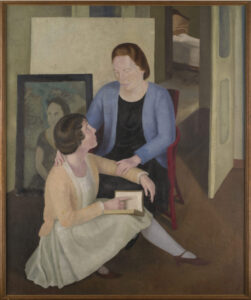A painter, a writer, and much more: the multiform vocation of Carlo Levi
 A painter, a writer, a doctor. Jewish, antifascist, journalist. Carlo Levi is one of the most complex and interesting figures in 19th-century Italian culture: a man of a multifaceted talent, driven by a profound humanity and an unquenchable thirst for knowledge. On the occasion of the 120th of his birth, many initiatives are under way in Italy to remember his remarkable legacy. Among them, the beautiful exhibition realized by the Fondazione Ragghianti in Lucca, to which the last issue of Pagine Ebraiche dedicated a feature, that explores the friendship between Carlo Levi and the art critic Ludovico Ragghianti through works of art, letters, documents, photographs, and footage and the initiatives organized in Levi’s hometown, Turin.
A painter, a writer, a doctor. Jewish, antifascist, journalist. Carlo Levi is one of the most complex and interesting figures in 19th-century Italian culture: a man of a multifaceted talent, driven by a profound humanity and an unquenchable thirst for knowledge. On the occasion of the 120th of his birth, many initiatives are under way in Italy to remember his remarkable legacy. Among them, the beautiful exhibition realized by the Fondazione Ragghianti in Lucca, to which the last issue of Pagine Ebraiche dedicated a feature, that explores the friendship between Carlo Levi and the art critic Ludovico Ragghianti through works of art, letters, documents, photographs, and footage and the initiatives organized in Levi’s hometown, Turin.
Titled “Tutta la vita è lontano” (All life is far), this latter project is organized by Circolo dei Lettori Foundation in collaboration with Camera – Italian Center for Photography, Gam – Turin Civic Gallery of Modern and Contemporary Art, and the Cinema Museum. “Returning Carlo Levi to his city and to all of Italy on the occasion of the 120th anniversary of his birth was an extraordinary adventure for the Circolo dei Lettori Foundation – explained the director Elena Loewenthal – a discovery that has broadened our horizons over time and in space making them gradually wider and unexpected”.
Loewenthal together with Luca Beatrice curated the exhibition “Journey in Italy: places and faces” inaugurated last week. On display, are thirty paintings made by Levi between 1923 and 1973 with two elements at the center, the landscape, and the portrait. “Works – explain the curators – that testify to the different stylistic developments of his research, which started at a very young age from a strongly ‘objective’ painting, then moved on to a more expressionist representation, and finally tuning in to a modern realism after World War II”. There are portraits made during his first trip to Paris, paintings marked by the experience of the Group of Six (Gigi Chessa, Nicola Galante, Francesco Menzio, Jessie Boswell, and Enrico Paolucci) and inspired by French post-impressionism, and then the influence of the confinement in Lucania, with the translation on canvas of his social commitment.
“Levi was able to work on figuration, choosing an alternative path to the more trodden paths of the twentieth century. – explained Beatrice – He is a figure to be known and interpreted especially in light of the role that intellectuals had in Italy at the time”.
